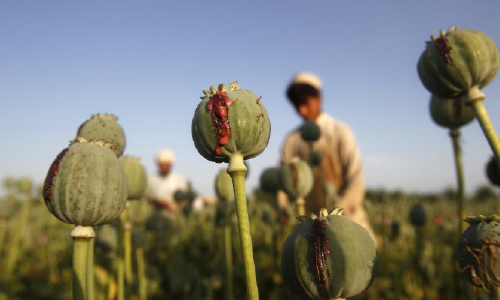KABUL - Opium production fell last year in Afghanistan due to severe drought, the United Nations Office on Drugs and Crime (UNODC) said on Wednesday.
In its annual report released in Vienna today, UNODC said drought in Afghanistan had led to a 25 percent drop in opium output to about 7,790 tons in 2018.
Overproduction of the drug in 2017 contributed to a fall in opium prices, according to the UNODC study, which noted a sharp hike in the number of affected individuals.
Around 35 million people were affected across the globe in 2017, some 4.5 million more than previously estimated.
"Six out of seven don´t receive the treatment they need," the organisation said, suggesting it could alter the numbers again were it given access to data from China.
In 2017, the report recalled, there were 53.4 million opioid users worldwide -- up by 56 percent from the 2016 estimate.
Global seizures of the synthetic opioid surged from less than 10 kilograms in 2010 to almost nine tonnes in 2013 and a record 125 tonnes in 2017.
Cannabis continued to be the most widely used drug, with an estimated 188 million people using it.
Synthetic opioids remain the main cause of opioid overdose deaths in the United States, which went up by 13 percent to more than 47,000 in 2017.
Cocaine production hit an all-time high in 2017, up by 25 percent. The yield largely increased in Colombia, where remote fields and criminal gangs jacked up production,
The surge came despite efforts to wean rural communities away from coca cultivation. "What is happening in Columbia is worrisome," said Angela Me, chief of research at UNODC. (Pajhwok)
Home » Afghanistan » Afghanistan’s Opium Production Down by 25pc
Afghanistan’s Opium Production Down by 25pc

